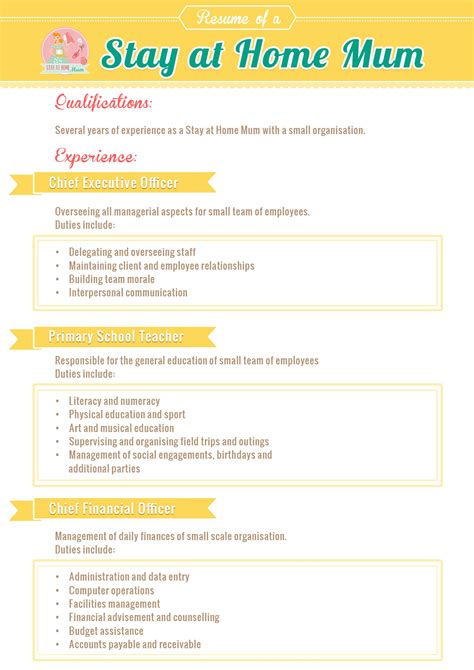Introduction
Being a stay-at-home mom (SAHM) is a demanding and rewarding role that encompasses a wide range of responsibilities and challenges. This job description aims to provide a comprehensive outline of the essential duties, skills, and qualifications required to excel as a SAHM.

Key Responsibilities
As a SAHM, you are responsible for:
- Providing a nurturing and stimulating environment for children, including physical care, emotional support, and intellectual development.
- Overseeing household management tasks such as cooking, cleaning, laundry, and budgeting.
- Maintaining a safe and organized home, ensuring that basic needs are met.
- Supporting the physical, mental, and emotional well-being of all family members.
- Managing appointments, errands, and other logistics related to family life.
Essential Skills and Qualifications
To effectively fulfill the responsibilities of a SAHM, you need:
- Unconditional love and patience for children.
- Strong organizational and multitasking abilities.
- Excellent communication and interpersonal skills.
- Knowledge of child development and parenting practices.
- Basic household management skills, including cooking, cleaning, and budgeting.
- Ability to prioritize tasks, manage time, and work independently.
- Physical stamina and good health to keep up with the demands of the role.
Professional Development
As a SAHM, continued professional development is crucial to maintain your skills and adapt to the evolving needs of your family. Consider:
- Attending parenting classes or workshops.
- Reading books and articles on child development and parenting techniques.
- Joining support groups or online forums for SAHMs.
- Volunteering or working part-time in a related field.
Compensation and Benefits
The compensation for SAHMs varies depending on factors such as location, family size, and individual circumstances. However, the benefits of this role include:
- Flexibility and work-life balance.
- Intrinsic rewards of raising and nurturing children.
- Opportunities for personal growth and development.
- Potential tax benefits, such as the Child and Dependent Care Tax Credit.
Rewards and Challenges
Being a SAHM offers numerous rewards, including:
- Witnessing the growth and development of your children firsthand.
- Building strong bonds with your family.
- Having a positive impact on your children’s lives.
However, there are also challenges:
- Lack of financial compensation.
- Social isolation or lack of adult companionship.
- Stress and burnout from the demands of the role.
Market Insight
According to the U.S. Bureau of Labor Statistics, approximately 8.5% of mothers with children under 18 years old in the United States are SAHMs. Research indicates that the number of SAHMs is gradually declining, as more women enter the workforce.
Conclusion
The role of a SAHM is essential for the well-being of families and the overall fabric of society. It requires a high level of dedication, skill, and resilience. By understanding the responsibilities, skills, and qualifications required, you can embark on this rewarding journey with confidence and success. Remember, being a SAHM is not just a job; it’s a calling that shapes the lives of both you and your loved ones.
FAQs
-
What are the most important qualities of a SAHM?
– Unconditional love, patience, organizational skills, strong communication, and knowledge of child development. -
How can SAHMs continue their professional development?
– Attend parenting classes, read parenting literature, join support groups, volunteer, or work part-time. -
What are the benefits of being a SAHM?
– Flexibility, intrinsic rewards, personal growth, and potential tax benefits. -
What are the challenges of being a SAHM?
– Lack of financial compensation, social isolation, and stress. -
What is the average compensation for SAHMs?
– Compensation varies significantly depending on individual circumstances. -
How many mothers in the U.S. are SAHMs?
– Approximately 8.5% of mothers with children under 18.
Table 1: Responsibilities of a SAHM
| Category | Responsibilities |
|---|---|
| Childcare | Physical care, emotional support, intellectual development |
| Household Management | Cooking, cleaning, laundry, budgeting |
| Home Maintenance | Ensuring safety and organization, meeting basic needs |
| Family Support | Physical, mental, and emotional well-being |
| Logistics Management | Appointments, errands, family-related tasks |
Table 2: Essential Skills for SAHMs
| Skill | Description |
|---|---|
| Child Development | Knowledge of child development stages and parenting practices |
| Communication | Effective communication with children, family, and others |
| Organization | Ability to prioritize, manage time, and work independently |
| Multitasking | Ability to handle multiple tasks simultaneously |
| Budgeting | Financial management skills for household expenses |
| Physical Stamina | Good health and energy to meet physical demands |
Table 3: Professional Development for SAHMs
| Activity | Benefits |
|---|---|
| Parenting Classes | Learn new parenting techniques and enhance knowledge |
| Reading | Stay up-to-date on child development and parenting |
| Support Groups | Connect with other SAHMs and gain support |
| Volunteering | Apply parenting skills in a related setting |
| Part-Time Work | Maintain skills, gain experience, and supplement income |
Table 4: Tips for SAHMs Facing Challenges
| Challenge | Tips |
|---|---|
| Lack of Financial Compensation | Consider part-time work, freelance, or online businesses |
| Social Isolation | Join support groups, attend classes, or volunteer to connect with others |
| Stress and Burnout | Establish self-care routines, delegate tasks, and seek support when needed |
